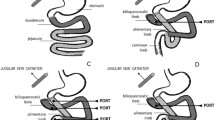Summary
The decrease in pancreatic exocrine secretion during the course of acute pancreatitis is a well-documented process. However, the mechanisms underlying this reduced pancreatic function are not fully understood. To analyze pancreatic protein synthesis and secretion during and after cerulein-induced pancreatitis, we performed the plasma amino acid consumption test on conscious rats. After stimulation with 1 μg cerulein/kg/h sc for 1 h, the control group with intact pancreas exhibited a decrease in plasma amino acid by about 15%, and this decrease could be abolished by the administration of the specific CCK-receptor antagonist, loxiglumide. Protein and amylase secretion were augmented by cerulein to about 400% of control values. Upon supramaximal stimulation of the pancreas with cerulein (20 μg/kg/h sc for 5 h), we observed a profound decrease of pancreatic secretion, which was accompanied by a more prolonged and more pronounced decrease of plasma amino acids (25%). Two hours after cessation of the supramaximal stimulation of pancreatic secretion (to induce pancreatitis), the administration of 1 μg/kg/h of cerulein for 1 h resulted in a further decrease of amino plasma acid level, whereas no stimulation of exocrine pancreatic secretion was observed. Eighteen hours later, repeated administration of 1 μg/kg/h of cerulein was still able to induce amino acid decrease by 20%, but again, no stimulation of exocrine pancreatic secretion was detectable. We conclude that, in the time course of acute cerulein-induced hyperstimulation, there might be an imbalance between synthesis of pancreatic enzymes (reflected by amino acid consumption) and the release of exocrine pancreatic secretion into the duodenum, which may be explained by leakage of proteolytic enzymes from damaged acinar cells into the extracellular space of the pancreas.
Similar content being viewed by others
References
Lombardi B, Estes LW, Longnecker DS. Acute hemorrhagic pancreatitis (massive necrosis) with fat necrosis induced in mice by DL-ethionine fed with a choline-deficient diet.Am J Pathol 1975; 79: 465–480.
Lampel M, Kern HF. Acute interstitial pancreatitis in the rat induced by excessive doses of a pancreatic secretagogue.Virchows Arch (A) 1977; 373: 97–117.
Adler G, Hupp T, Kern HF. Course and spontaneous regression of acute pancreatitis in rats.Virchows Arch (A) 1979; 31: 282–294.
Robert A, Lum JT, Lancaster C, Olafsson AS, Kolbasa KP, Nezamis JE. Prevention by prostaglandin of caerulein-induced pancreatitis in rats.Lab Invest 1989; 60: 677–691.
Adler G, Rohr G, Kern HF. Alteration of membrane fusion as cause of acute pancreatitis in the rat.Dig Dis Sci 1982; 27: 993–1002.
Scheele G, Adler G, Kern HF. Exocytosis occurs at the basolateral plasma membrane of the pancreatic acinar cell during supramaximal secretagogue stimulation.Gastroenterology 1987; 92: 345–353.
Domschke S, Heptner G, Kolb S, Sailer D, Schneider M, Domschke W. Decrease in plasma amino acid level after secretin and pancreozymin as an indicator of exocrine pancreatic function.Gastroenterology 1986; 90: 1031–1038.
Allen AM, Oates PS. Measuring total plasma amino acid concentration as a test of exocrine pancreatic function.Gut 1992; 33: 392–396.
Konturek SJ, Szlachcic A, Dembinski A, Warzecha Z, Jaworek J, Stachura J. Nitric oxide in pancreatic secretion and hormone-induced pancreatitis in rats.Int J Pancreatol 1994; 15: 19–28.
Konturek SJ, Krzyzek E, Bilski J. The importance of gastric secretion in the feedback control of interdigestive and postprandial pancreatic secretion in rats.Regul Pept 1991; 36: 85–97.
Bernfeld P. Amylase alpha and beta.Methods Enzymol 1955; 5: 139–148.
Gerok W, Talke H, Maier KP. Störungen des Protein- und Aminosäurenstoffwechsels, inKlinische Hepatologie, Kuhn HA, Wernze H, eds., Stuttgart, Thieme Verlag 1979; 3: pp. 28–44.
Gullo L, Pezzilli R, Barbara L. Effect of somatostatin on plasma amino acid uptake by human pancreas.Gastroenterology 1989; 97: 732–736.
Gullo L. Effect of pancreatic polypeptide, thyrotropin-releasing hormone and glucagon on plasma amino acid uptake by human pancreas.Gastroenterology 1991; 100: 1095–1099.
Begin N, Scholefield PG. The uptake of amino acids by mouse pancreas in vitro.Biochim Biophys Acta 1964; 90: 82–89.
Van Venrooij WJ, Poort C, Kramer MF, Janssen MT. Relationship between extracellular amino acids and protein synthesis in vitro in the rat pancreas.Eur J Biochem 1972; 30: 427–433.
Gabryelewicz A, Kulesza E, Konturek SJ. Comparison of loxiglumide, a cholecystokinin receptor antagonist, and atropine on hormonal and meal-stimulated pancreatic secretion in man. Scan J Gastroenterol 1990; 25: 731–738.
Adler G, Beglinger C, Braun V, Reinshagen M, Koop I, Schaffmayer A, Rovati LC, Arnold R. Interaction of the cholinergic system and cholecystokinin in the regulation of endogenous and exogenous stimulation of pancreatic secretion in humans.Gastroenterology 1991; 100: 537–543.
Schwarzendrube J, Niederau M, Lüthen R, Niederau C. Effects of cholecystokinin-receptor blockade on pancreatic and binary function in healthy volunteers.Gastroenterology 1991; 100: 1683–1690.
Konturek JW, Gabryelewicz A, Kulesza E, Konturek SJ, Domschke W. Cholecystokinin (CCK) in the amino acid uptake and enzyme protein secretion by the pancreas in humans.Int J Pancreatol 1995; 17: 55–61.
Gorelick FS, Adler G, Kern HF. Caerulein-induced pancreatitis, inThe Pancreas: Biology, Pathobiology and Disease, Go VLW, ed., Raven, New York, 1993; pp. 501–526.
Author information
Authors and Affiliations
Rights and permissions
About this article
Cite this article
Fischer, H., Konturek, J.W., Szlachcic, A. et al. Plasma amino acid consumption and pancreatic secretion during and after cerulein-induced pancreatitis in rats. Int J Pancreatol 18, 127–134 (1995). https://doi.org/10.1007/BF02785886
Received:
Revised:
Accepted:
Issue Date:
DOI: https://doi.org/10.1007/BF02785886




